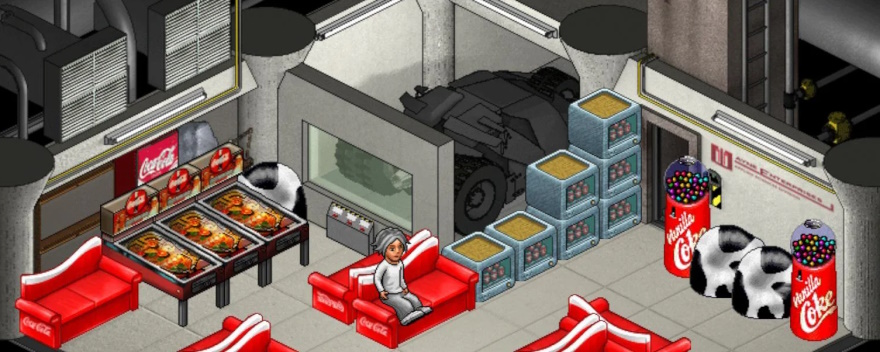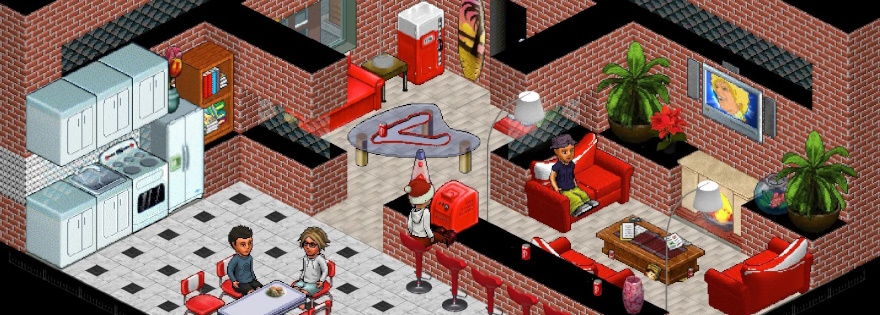
Part of the sheer joy and fun of the early online world of the late ’90s and early 2000s was the experimentation that took place. Even as MMORPGs were taking off during that time, so too were other types of virtual worlds — such as those that hosted online chat. People who had grown up with ICQ and AIM were natural adopters of the next stage of conversational evolution, which was to plop player avatars down into visual hangouts and let them have fun playing house, bumping into others, and exploring these wacky worlds.
This gave rise to spaces such as Habbo Hotel, Club Penguin, The Sims Online, and even McDonald’s McWorld. Also attempting to ride this trend of (mostly) youth culture to hopeful future profits was Coca-Cola, which knocked back a tall glass of sugar water, cracked its knuckles, and whipped up its own red-and-white virtual world.
 The idea behind MyCoke was pretty simple: Create an attractive and fun virtual hangout space that would attract youth, and oh-so-subtly plaster Coca-Cola imagery in every square nook and corner until the kids forgot that there were other colors than red and white.
The idea behind MyCoke was pretty simple: Create an attractive and fun virtual hangout space that would attract youth, and oh-so-subtly plaster Coca-Cola imagery in every square nook and corner until the kids forgot that there were other colors than red and white.
Coca-Cola wasn’t interested in building a brand-new world and engine from scratch. Instead, it roped in VML and Sulake Corporation, the makers of Habbo Hotel, to use that same tech and visual style… y’know, just with more diabetes-injecting drink substances. The title came out in 2002 initially as Coke Music, after which it transitioned into Coke Studios before finally becoming MyCoke. I’ll just be calling it MyCoke for the rest of this piece, as the name changes were unnecessarily confusing.
In MyCoke, Players created avatars called “V-egos” with all the baggy pants and other street wear you could handle. All of this took place over several neighborhoods themed after various real world locales, such as Tokyo, Sydney, and London, which was further split between public and private spaces.
But to keep the youths there, Coke knew it needed more than just a Habbo reskin. The hook of this game came in the form of a music maker, which let players take turn creating phat beats for others to enjoy. If the composition was particularly lit, then that player would earn “decibel” currency that could be spent to deck out their crib to make it whack, yo.
And that’s the end of me trying to appropriate slang. I apologize.
The music mixer was a surprisingly robust tool that allowed for a great deal of creativity, and novice artists could try their hand at spinning a track that would impress all of the virtual club-goers. Alternatively, they could just steal ideas and templates from others, but that’s the music biz.
“Basically, it was an MMO and you make beats to earn money and buy furniture for your apartment to have dope parties,” one player fondly recalled.
Of course, Coca-Cola hoped that it would increase sales of its acidic obesity mixture with some synergy and whatnot, so it helpfully informed players that they could also rack up decibel currency by helping this old-timey company out by purchasing some actual Coke and turning in the codes printed on the caps. Other ways to earn decibels included participating in various in-game activities, drinking virtual Cokes, and turning in surveys to Coca-Cola’s marketing arm.
The fact that players, usually ones too young to have credit cards, could earn currency and buy all of the items in the store made MyCoke quite attractive.
From all reports, MyCoke was fairly successful, seeing the game become one of the most-visited online games by 2005. It continued to operate for a good half-decade — from 2002 to July 31st, 2007 — while users nested in this corporate world and connected with friends from across the world. A UK-based server of the game only lasted until 2006, however.
At the height of its popularity and funding, MyCoke invested even more into synergy and cross-promotion by sponsoring Batman Begins, American Idol, and FIFA. There was even a Shark Tale sponsorship that reskinned the whole game for a short while to make it underwater-themed.
But then Coke decided that it was easier promoting another game in which it had an advertising presence (which would be There, another virtual world that we will talk about at some point). Thus, MyCoke was shuttered and users were encouraged to migrate over to CC-Metro, a subsection of There run by Coca-Cola. CC-Metro only lasted to 2010 and the downfall of There.
Yet it’s not a title that’s faded away completely. As a free early online MMO, many cash-strapped kids and teens jumped into MyCoke and have fond memories as a result. Subsequent years brought about petitions to bring the game back, a replica of the music maker, a nostalgic Reddit, and a rogue server called Cavejam.
I guess this goes to show that even seedy capitalism can generate something positive and enduring — even if the experience of chugging the product in question is like sticking your tongue on a nine-volt battery.
 Believe it or not, MMOs did exist prior to 2004! Every few weeks, The Game Archaeologist looks back at classic online games and their history to learn a thing or two about where the industry came from… and where it might be heading.
Believe it or not, MMOs did exist prior to 2004! Every few weeks, The Game Archaeologist looks back at classic online games and their history to learn a thing or two about where the industry came from… and where it might be heading.
















